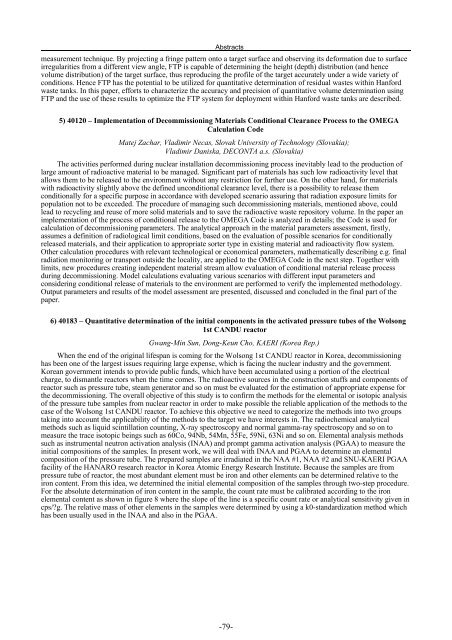ASME Message
ASME Message
ASME Message
Create successful ePaper yourself
Turn your PDF publications into a flip-book with our unique Google optimized e-Paper software.
Abstracts<br />
measurement technique. By projecting a fringe pattern onto a target surface and observing its deformation due to surface<br />
irregularities from a different view angle, FTP is capable of determining the height (depth) distribution (and hence<br />
volume distribution) of the target surface, thus reproducing the profile of the target accurately under a wide variety of<br />
conditions. Hence FTP has the potential to be utilized for quantitative determination of residual wastes within Hanford<br />
waste tanks. In this paper, efforts to characterize the accuracy and precision of quantitative volume determination using<br />
FTP and the use of these results to optimize the FTP system for deployment within Hanford waste tanks are described.<br />
5) 40120 – Implementation of Decommissioning Materials Conditional Clearance Process to the OMEGA<br />
Calculation Code<br />
Matej Zachar, Vladimir Necas, Slovak University of Technology (Slovakia);<br />
Vladimir Daniska, DECONTA a.s. (Slovakia)<br />
The activities performed during nuclear installation decommissioning process inevitably lead to the production of<br />
large amount of radioactive material to be managed. Significant part of materials has such low radioactivity level that<br />
allows them to be released to the environment without any restriction for further use. On the other hand, for materials<br />
with radioactivity slightly above the defined unconditional clearance level, there is a possibility to release them<br />
conditionally for a specific purpose in accordance with developed scenario assuring that radiation exposure limits for<br />
population not to be exceeded. The procedure of managing such decommissioning materials, mentioned above, could<br />
lead to recycling and reuse of more solid materials and to save the radioactive waste repository volume. In the paper an<br />
implementation of the process of conditional release to the OMEGA Code is analyzed in details; the Code is used for<br />
calculation of decommissioning parameters. The analytical approach in the material parameters assessment, firstly,<br />
assumes a definition of radiological limit conditions, based on the evaluation of possible scenarios for conditionally<br />
released materials, and their application to appropriate sorter type in existing material and radioactivity flow system.<br />
Other calculation procedures with relevant technological or economical parameters, mathematically describing e.g. final<br />
radiation monitoring or transport outside the locality, are applied to the OMEGA Code in the next step. Together with<br />
limits, new procedures creating independent material stream allow evaluation of conditional material release process<br />
during decommissioning. Model calculations evaluating various scenarios with different input parameters and<br />
considering conditional release of materials to the environment are performed to verify the implemented methodology.<br />
Output parameters and results of the model assessment are presented, discussed and concluded in the final part of the<br />
paper.<br />
6) 40183 – Quantitative determination of the initial components in the activated pressure tubes of the Wolsong<br />
1st CANDU reactor<br />
Gwang-Min Sun, Dong-Keun Cho, KAERI (Korea Rep.)<br />
When the end of the original lifespan is coming for the Wolsong 1st CANDU reactor in Korea, decommissioning<br />
has been one of the largest issues requiring large expense, which is facing the nuclear industry and the government.<br />
Korean government intends to provide public funds, which have been accumulated using a portion of the electrical<br />
charge, to dismantle reactors when the time comes. The radioactive sources in the construction stuffs and components of<br />
reactor such as pressure tube, steam generator and so on must be evaluated for the estimation of appropriate expense for<br />
the decommissioning. The overall objective of this study is to confirm the methods for the elemental or isotopic analysis<br />
of the pressure tube samples from nuclear reactor in order to make possible the reliable application of the methods to the<br />
case of the Wolsong 1st CANDU reactor. To achieve this objective we need to categorize the methods into two groups<br />
taking into account the applicability of the methods to the target we have interests in. The radiochemical analytical<br />
methods such as liquid scintillation counting, X-ray spectroscopy and normal gamma-ray spectroscopy and so on to<br />
measure the trace isotopic beings such as 60Co, 94Nb, 54Mn, 55Fe, 59Ni, 63Ni and so on. Elemental analysis methods<br />
such as instrumental neutron activation analysis (INAA) and prompt gamma activation analysis (PGAA) to measure the<br />
initial compositions of the samples. In present work, we will deal with INAA and PGAA to determine an elemental<br />
composition of the pressure tube. The prepared samples are irradiated in the NAA #1, NAA #2 and SNU-KAERI PGAA<br />
facility of the HANARO research reactor in Korea Atomic Energy Research Institute. Because the samples are from<br />
pressure tube of reactor, the most abundant element must be iron and other elements can be determined relative to the<br />
iron content. From this idea, we determined the initial elemental composition of the samples through two-step procedure.<br />
For the absolute determination of iron content in the sample, the count rate must be calibrated according to the iron<br />
elemental content as shown in figure 8 where the slope of the line is a specific count rate or analytical sensitivity given in<br />
cps/?g. The relative mass of other elements in the samples were determined by using a k0-standardization method which<br />
has been usually used in the INAA and also in the PGAA.<br />
-79-


